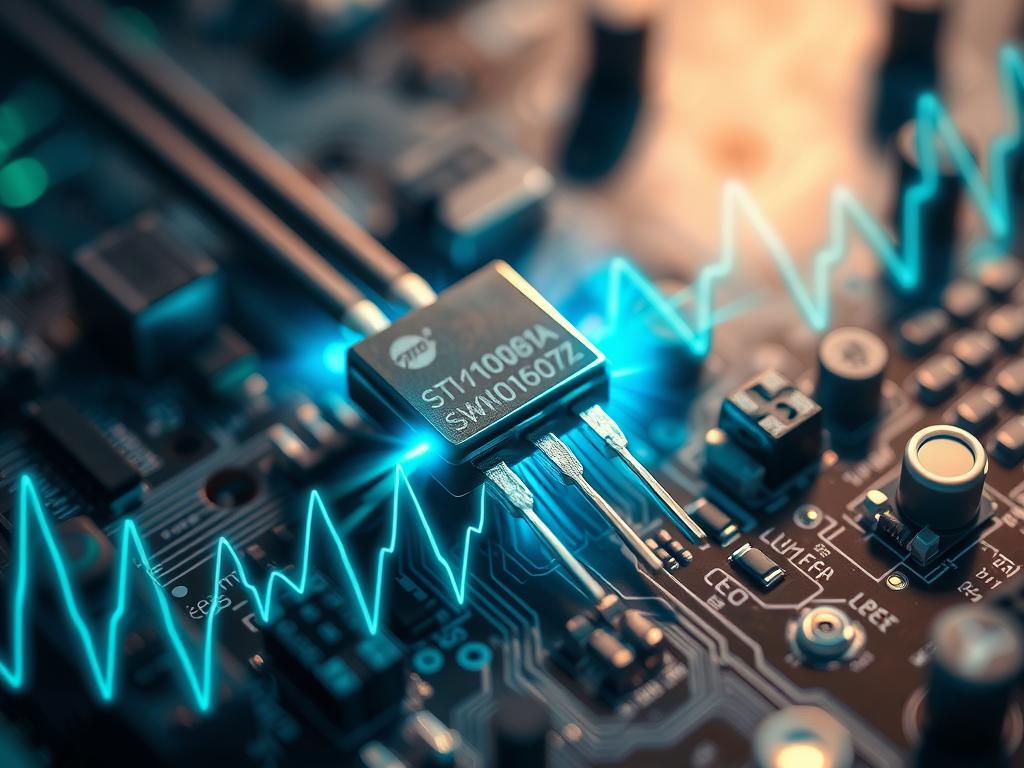In the world of electronics, how well devices work is key. Transistors, the basic parts of today’s electronics, are crucial for speed and reliability. The recovery time is at the center of this, affecting how fast and well transistors work.
Transistors, like MOSFETs, are known for quick switching and low resistance. But, they have a body diode that can slow down reverse current blocking. This delay, called reverse recovery time, is important for how well transistors perform, especially in power electronics.
Knowing about recovery time in transistors is vital for better electronic circuit design. It not only speeds up switching but also boosts efficiency, signal quality, and reliability. By exploring recovery time, experts can improve circuit designs and increase semiconductor device performance.
Key Takeaways
- Recovery time is a critical parameter that affects the switching speed and performance of transistors.
- Reverse recovery time, the delay when the gate toggles between reverse and forward operation, can impact the efficiency of power electronics applications.
- Optimizing recovery time is essential for improving circuit design, signal integrity, and overall reliability.
- Understanding the factors that influence recovery time, such as material properties, environmental conditions, and device architecture, is crucial for enhancing transistor performance.
- Careful consideration of recovery time is necessary for high-frequency applications, where it can pose significant challenges.
Understanding Recovery Time in Transistors
In the world of electronics, recovery time is key to understanding transistor behavior. It’s the time a transistor takes to stop conducting after it starts. This brief period is known as undershoot, where the signal leaks through.
This is very important in power-efficient integrated circuit design and high-frequency uses, like switching power supplies.
Definition of Recovery Time
Recovery time, or reverse recovery time, is vital for diodes and transistors. It’s the time it takes for a device to stop conducting. This time is key to a circuit’s signal processing capabilities and power efficiency.
Importance of Recovery Time in Circuit Design
The reverse recovery time of a transistor or diode is crucial in electronic circuit design. A longer recovery time means more power loss during switching, lowering efficiency. On the other hand, a shorter recovery time means faster switching and better signal processing capabilities in high-frequency uses.
So, understanding and optimizing recovery time is essential in integrated circuit design and power system engineering.
“The reverse recovery time is particularly significant in switching power supplies and high-frequency applications. For instance, a BAT42 Schottky diode has a reverse recovery time of no more than 5 ns at 10mA.”
The Role of Transistors in Electronics
Transistors are key to modern electronics. They act as switches controlled by electricity in many devices. These devices are crucial for making electronics smaller and more efficient.
Types of Transistors
There are two main types of transistors: bipolar junction transistors (BJTs) and field-effect transistors (FETs). BJTs, like bipolar transistors, control current flow. FETs, like MOSFETs, control current based on gate voltage.
How Transistors Function in Circuits
- Transistors act as electrically controlled switches, allowing or blocking the flow of current in a circuit.
- In digital electronics, transistors are used to construct logic gates and other digital components, enabling the processing of binary data.
- In analog electronics, transistors are employed in amplifiers, oscillators, and other circuits that handle continuously varying signals.
- The fast switching capabilities and low ON-state resistance of high-frequency applications, such as metal-oxide-semiconductor field-effect transistors (MOSFETs), make them valuable in advanced power electronics applications.
| Transistor Type | Applications | Advantages |
|---|---|---|
| Bipolar Junction Transistors (BJTs) | Analog amplifiers, switching circuits | High current gain, simple structure |
| Field-Effect Transistors (FETs) | Digital electronics, power electronics | High input impedance, low noise, high switching speed |
Transistors have been vital for electronic circuit progress. They’ve helped in creating modern digital electronics and power electronics. This has led to smaller, better electronic devices.

Factors Affecting Recovery Time
The recovery time of semiconductor devices is key to their performance. It’s influenced by material properties, environmental conditions, and device architecture. Knowing these factors helps improve device performance and circuit design.
Material Properties
The material of the semiconductor is crucial. It affects how charge carriers move and recover. For example, how fast the current changes (di/dt) impacts recovery time. The package’s thermal resistance also plays a role, as it affects how hot the device gets during switching.
Environmental Conditions
Temperature and humidity also affect recovery time. Higher temperatures can speed up carrier movement and reduce resistance. But, lower temperatures slow down recovery due to reduced mobility and increased resistance.
Device Architecture
The design of the semiconductor device is important too. The type of transistor, channel length, and gate oxide thickness all matter. Field-effect transistors (FETs) usually recover faster than bipolar junction transistors (BJTs) because of their structure and switching.
By optimizing these factors, engineers can make better devices and circuits. This leads to improved performance, reliability, and signal quality. It makes electronic systems more efficient and functional.
Measuring Recovery Time in Transistors
Figuring out a transistor’s recovery time is key to knowing its switching abilities. This time shows how long it takes for the transistor to switch off after being on. It’s important for the transistor’s speed and how it handles.
Methods of Measurement
To measure recovery time, we watch how the transistor acts when switching. We use oscilloscopes and special tools to see these changes. The datasheets of transistors often list the reverse recovery time and charge, helping designers.
Tools and Techniques Used
- Oscilloscope: This tool lets engineers see and study the transistor’s switching actions. It shows the rise and fall times and the recovery period.
- Specialized Test Equipment: Tools like transistor analyzers and curve tracers are made to measure recovery time and other important transistor features.
- Datasheet Review: Looking at the datasheet is essential. It usually has the reverse recovery time and charge, helping pick the right transistor for a project.
- Reverse Recovery Charge Measurement: For MOSFETs, we measure the reverse recovery charge at a certain rate of change in the drain-source current (di/dt).
Using these methods and tools, engineers can learn more about transistors’ recovery times. This knowledge helps them design and improve circuits.
| Measurement Parameter | Typical Range | Factors Affecting |
|---|---|---|
| Reverse Recovery Time | 10 ns to 1 μs | Material properties, device architecture, environmental conditions |
| Reverse Recovery Charge | 1 nC to 1 μC | Material properties, device architecture, di/dt rate |

“The recovery time calculation uses a linear equation: tREC = a * N + b, where N is the number of parasitically powered slave devices on the network connected in parallel.”
Knowing how to measure recovery time helps electronics experts. They can better choose transistors for their transistor switching speed and signal processing capabilities needs.
Impact of Recovery Time on Performance
Transistor recovery time is key to electronic circuit performance. It affects switching speed and signal quality. These are crucial for efficient and fast circuit design.
How Recovery Time Affects Speed
Longer recovery times in transistors increase switching losses. This can slow down circuit efficiency and speed. For instance, MOSFET devices face losses due to reverse recovery charge, peak voltage, and frequency.
These losses can heat up the circuit. This limits its overall performance.
Effects on Signal Integrity
Transistor recovery time also impacts signal quality. Slow recovery can cause voltage spikes and electromagnetic interference. These issues can degrade signal quality and introduce errors in digital circuits.
Managing recovery time is vital. It ensures signal integrity and reliable circuit operation.
| Parameter | Silicon Carbide (SiC) | Gallium Nitride (GaN) |
|---|---|---|
| Gate Charge | 4 nC-Ω | Less than 1 nC-Ω |
| Output Charge | 25 nC-Ω | 5 nC-Ω |
| Voltage Levels | Up to 1,200 V | 600 V |
| Switching Speed | Up to 150 V/ns | Up to 150 V/ns |
| Efficiency | 99.2% in Three-Phase Grid | 99.2% in Three-Phase Grid |
| Power Density | 211 W/in^3 (Multilevel Converters) | 211 W/in^3 (Multilevel Converters) |
The table shows SiC and GaN transistors’ performance. They offer better recovery time, speed, efficiency, and signal quality. These advancements are key for modern circuit design.
Recovery Time in Different Transistor Technologies
Transistor recovery time is key in semiconductor device performance and circuit design. Various transistor types, like BJTs, FETs, and SCRs, have different recovery times. These times affect their use in different applications.
Bipolar Junction Transistors (BJTs)
BJTs have a slower recovery time than other types. Their reverse recovery time goes down with higher collector current density. But, it goes up with higher collector breakdown voltage.
Improving reverse recovery time can be done, but it often raises the collector-emitter voltage. This is more noticeable in low-voltage BJTs and high-voltage ones at low collector current densities.
Field-Effect Transistors (FETs)
MOSFETs, a type of FET, are known for their quick switching. Yet, they also face recovery time issues due to their body diode. The recovery time of FETs can change based on device design, material, and environment, as research shows.
Silicon Controlled Rectifiers (SCRs)
SCRs have their own recovery time factors. Their recovery time is affected by gate drive, load, and device structure. Choosing the right SCRs is key for good performance and less recovery time issues in circuits.
Choosing a transistor technology depends on recovery time, switching speed, and other factors. Engineers must look at these characteristics to ensure their circuits work well and reliably.
| Transistor Technology | Recovery Time Characteristics | Typical Applications |
|---|---|---|
| Bipolar Junction Transistors (BJTs) | Relatively slower recovery time, but can be improved with design modifications | Power electronics, amplifiers, switches |
| Field-Effect Transistors (FETs) | Fast switching capabilities, but still affected by body diode recovery time | Digital logic, RF circuits, power electronics |
| Silicon Controlled Rectifiers (SCRs) | Recovery time influenced by gate drive, load characteristics, and device structure | Power conversion, motor control, industrial automation |

“The choice of transistor technology depends on the specific application requirements and the trade-offs between recovery time, switching speed, and other performance parameters.”
Recovery Time in High-Frequency Applications
In high-frequency applications, recovery time is very important. Transistors in RF (radio frequency) circuits need to recover quickly to keep signals clear and efficient. As frequencies get higher, recovery time’s impact grows, causing distortion and power loss if not managed well.
Importance for RF Circuits
RF circuits, like those in communication systems and radar, need transistors that work well at high frequencies. The recovery time of these transistors is key to the circuit’s signal processing. Designers must pick transistors with the right recovery time to keep signals strong and prevent loss at high frequencies.
Challenges Faced at High Frequencies
At higher frequencies, recovery time’s effects are more noticeable. Even small delays in a transistor’s recovery can cause big signal distortion, power loss, and inefficiency. Designers must find the right balance between recovery time, device performance, and circuit design for the best results at high frequencies.
The choice of transistor technology, material, and design all affect recovery time. It’s crucial to consider these factors for high-performance, high-frequency electronics.
“Selecting the right transistors with minimal recovery time is crucial for maintaining signal integrity and efficiency in high-frequency applications.”
The evolution of transistor technology has driven progress in high-frequency applications. From early consumer electronics to today’s advanced communication systems, the quest for faster, more efficient transistors has never stopped.
Designing for Optimal Recovery Time
In the world of integrated circuit design and electronic circuit design, recovery time is key. It’s the time a transistor takes to go back to its off-state after being on. This time affects how well and efficiently a circuit works.
Strategies for Minimizing Recovery Time
To get the best recovery time, designers use several strategies. These include:
- Choosing transistors with low reverse recovery charge helps them switch back to off-state faster.
- Using surface-mount packages can help keep the circuit cool, which is good for recovery time.
- Designing circuits that don’t switch on and off as much can also help reduce recovery time’s impact.
Trade-offs in Design Choices
But, designing for fast recovery time means making choices that balance different needs. For instance, picking a transistor with less reverse recovery charge might make it more resistant to current but less strong. Designers must weigh these trade-offs to get the best results for their project.
By knowing how to reduce recovery time and understanding the design trade-offs, electronics experts can make circuits that work better and last longer. This improves the performance of many electronic devices.
Common Applications of Transistors
Transistors are key in modern electronics. They are used in many areas, like power converters, signal processors, and amplifiers. These devices help make electronic systems better and more efficient.
Power Converters
In power converter circuits, like switching power supplies, transistors’ recovery time is very important. A faster recovery time means better power efficiency. This leads to less heat and better energy use in power conversion devices.
Signal Processors
Signal processing needs fast and precise transistors. Their quick switching and control are key for handling signals well. This is crucial for digital signal processing in many electronic devices.
Amplifiers
Transistors are vital in amplifier circuits. They boost and shape electrical signals. The recovery time of these transistors affects how well the signal is amplified. It ensures the signal quality is maintained across different frequencies.
| Application | Importance of Transistor Recovery Time |
|---|---|
| Power Converters | Faster recovery time improves power efficiency and reduces heat generation. |
| Signal Processors | Rapid switching speeds enable accurate signal manipulation and processing. |
| Amplifiers | Recovery time affects signal fidelity and quality across different frequencies. |
Transistors are essential in many fields, from power electronics to signal processing and amplification. They drive innovation and help advance many industries.
Testing Recovery Time in Transistors
Measuring the recovery time of transistors is key for top-notch semiconductor device performance. The time it takes for a transistor to get back to its original state after switching off is vital. It affects the speed and efficiency of electronic circuits.
Standard Testing Procedures
Special tools and methods are used to test transistor recovery time. The main approach is using pulse generators and oscilloscopes. These tools help engineers see how the transistor responds when switched.
By sending input pulses and recording the output, engineers can find out the recovery time. This is how they get precise data on how fast transistors switch back.
Challenges in Testing
Getting accurate recovery time data is tough. It needs fast measurement tools because recovery times are in nanoseconds. Also, stray elements in the setup can mess with the results.
Designing circuits carefully and calibrating them is essential. This ensures the data is reliable and accurate. It’s important for picking the right transistors and designing better circuits.
For this, detailed testing and advanced methods are needed. They help get the right recovery time data for different transistor types.

Recovery Time: A Key Factor in Reliability
In the world of integrated circuit design, power efficiency is key. Recovery time is a big factor in a transistor’s reliability. Too much heat from recovery losses can shorten its life, making recovery time very important for designers.
Long-Term Reliability Considerations
The thermal resistance of the transistor package is crucial. As transistors switch fast, recovery losses can build up. This can lead to high temperatures and faster wear down of devices. Designers must balance power efficiency, design, and reliability when managing recovery time.
Effects of Recovery Time on Lifespan
- Bias temperature instabilities (BTI) can cause a current drift over time, affecting the threshold voltage (ΔVth).
- Nanoscale MOS transistors show current steps due to defect charge transitions, impacting their behavior.
- Scaling devices reduces defects but makes each defect’s impact greater, allowing for detailed defect studies.
- Time-dependent defect spectroscopy (TDDS) helps study multiple defects, improving over random telegraph noise (RTN) signals.
It’s vital for engineers to understand how recovery time, power efficiency, and design are linked. By managing these, they can make circuits that last longer and work better. This is key for modern electronics.
Transconductance is crucial in electroniccircuit, affecting amplifiers’ ability to convert input voltage to output current, which in turn impacts gain, linearity, and frequency response.
“The existence of two mechanisms in NBTI has caused scientific controversy over their relative importance and the mechanism of generation and recovery of interface states.”
Future Developments in Recovery Time Optimization
The electronics world is always pushing to improve how fast semiconductors work. This includes making transistors recover faster. New materials like wide-bandgap semiconductors are leading this charge. They promise to cut down recovery time and open up new possibilities in fast and powerful electronics.
Emerging Materials and Technologies
Two materials, silicon carbide (SiC) and gallium nitride (GaN), are getting a lot of attention. SiC has a bandgap of about 3.3 eV, while GaN is close with 3.4 eV. These materials can handle high voltages, switch quickly, and have low resistance. This makes them perfect for semiconductor device performance and high-frequency applications.
Researchers are working hard to improve SiC and GaN transistors. They’re looking at better ways to make them and design them. There’s also interest in even wider bandgap materials like diamond, which could lead to huge improvements in power and speed.
Trends in Transistor Design and Application
New technologies are leading to changes in how transistors are designed and used. People are exploring new architectures, packaging, and ways to manage heat. These efforts aim to boost semiconductor device performance and high-frequency applications. They’re opening up new areas like power electronics, RF circuits, and aerospace.
But these fast transistors also bring new challenges. They can cause more electromagnetic interference (EMI) and need special design and filtering. Engineers must find the right balance to make sure these devices work well and efficiently.

The quest to improve transistor recovery time is ongoing. By using new materials and technologies, engineers are on the verge of big breakthroughs. These advancements will lead to exciting new applications in the future.
Conclusion: The Importance of Recovery Time in Transistor Design
Recovery time is key in transistor design. It affects how fast and efficient transistors switch. This is vital for electronic circuit design and high-frequency use. As tech advances, so will the need to improve recovery time.
Summary of Key Points
This article showed how crucial recovery time is in transistor design. We covered what it is, why it matters, and how it affects performance. We also talked about the challenges in different transistor types and how to overcome them.
Final Thoughts on Recovery Time
As electronics get more complex and power-hungry, improving transistor speed and efficiency is essential. Recovery time is a critical factor in achieving this. By tackling recovery time challenges, engineers can create better, more efficient circuits for today’s tech needs.


